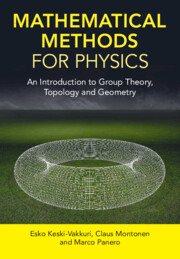Mathematical Methods for Physics
This detailed yet accessible text provides an essential introduction to the advanced mathematical methods at the core of theoretical physics. The book steadily develops the key concepts required for an understanding of symmetry principles and topological structures, such as group theory, differentiable manifolds, Riemannian geometry, and Lie algebras. Based on a course for senior undergraduate students of physics, it is written in a clear, pedagogical style and would also be valuable to students in other areas of science and engineering. The material has been subject to more than twenty years of feedback from students, ensuring that explanations and examples are lucid and considered, and numerous worked examples and exercises reinforce key concepts and further strengthen readers' understanding. This text unites a wide variety of important topics that are often scattered across different books, and provides a solid platform for more specialized study or research.
- Unites a wide variety of important topics that are often scattered across different books
- Written in a clear, pedagogical style and accessible to students from physics, mathematics, and engineering
- Numerous worked examples and exercises reinforce key concepts and further strengthen readers' understanding
Reviews & endorsements
'The recent explosive development of topological quantum matter requires a deep systematic understanding of modern mathematics. Quantum many-body entanglement in topological quantum matter is a new phenomenon that requires new mathematical language to describe. This is a rare book that provides systematic and in-depth coverage of some of the most important mathematical concepts, such as groups, geometry, topology and algebra, among others. Many abstract mathematical notions are explained in an easy, explicit fashion. This is an in-depth, friendly book on modern mathematics. Very timely and highly recommended.' Xiao-Gang Wen, Massachusetts Institute of Technology
Product details
December 2022Hardback
9781107191136
400 pages
262 × 184 × 26 mm
0.89kg
Available
Table of Contents
- 1. Introduction
- 2. Group theory
- 3. Representation theory of groups
- 4. Differentiable manifolds
- 5. Riemannian geometry
- 6. Semisimple Lie algebras and their unitary representations
- Appendix A
- References
- Index.





